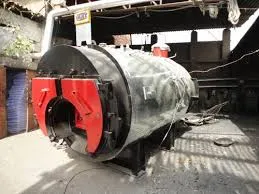
Sep . 22, 2024 15:31 Back to list
types of steam boilers used in industry
Steam boilers are essential components in many industrial processes, providing the necessary heat and energy to meet operational demands. There are various types of steam boilers utilized in industries, each designed to suit specific requirements based on factors such as pressure, temperature, and application. Here, we explore some of the most common types of steam boilers used in industrial settings.
1. Fire-Tube Boilers This type of boiler consists of a series of tubes through which hot gases pass. The surrounding water is heated by the conduction of heat through the tube walls. Fire-tube boilers are known for their simplicity and ease of operation, making them suitable for a range of applications. They are typically used in small to medium-sized industries where steam demand is moderate.
2. Water-Tube Boilers Unlike fire-tube boilers, water-tube boilers have water-filled tubes with hot gases passing around them. This design allows for higher pressure and temperature operations, making water-tube boilers ideal for large-scale industrial applications. They are commonly found in power plants and large manufacturing facilities, where they generate steam for turbines, heating, and other processes.
3. Biomass Boilers As industries move towards sustainable practices, biomass boilers have gained popularity. These boilers use organic materials, such as wood pellets or agricultural waste, as fuel sources. Biomass boilers not only provide steam but also contribute to reducing carbon emissions. They are increasingly used in industries looking to enhance their environmental sustainability.
4. Electric Boilers These boilers use electricity as a heat source to produce steam. They are especially useful in locations where there is a lack of traditional fuel sources or where emissions regulations are stringent. Electric boilers offer precise control over steam production, making them suitable for industries like pharmaceuticals and food processing, where stringent quality control is essential.
types of steam boilers used in industry

5. Condensing Boilers This type of boiler is designed to recover and utilize exhaust heat that would otherwise be lost. Condensing boilers achieve higher efficiencies by utilizing the latent heat in flue gases to pre-heat the incoming water. They are often used in combined heat and power (CHP) systems and in applications where energy efficiency is a priority.
6. Combi Boilers Combination boilers provide both heating and hot water in a single unit. They are particularly suited for smaller industrial facilities or processes with fluctuating steam demands. Their efficient design allows for space savings and reduced overhead costs.
7. Modular Boilers These are smaller, easily transportable units that can be linked together to meet varying levels of steam demand. Modular boilers are increasingly preferred for their flexibility and ease of installation, making them ideal for temporary projects or sites where space is limited.
In conclusion, the choice of steam boiler in an industrial setting is influenced by numerous factors, including steam demand, efficiency needs, and environmental considerations. Understanding the different types of steam boilers available allows industries to select the most appropriate technology, ultimately enhancing productivity and sustainability.
-
Efficient Biomass Fired Hot Water Boiler | AI Heating Solution
NewsAug.01,2025
-
High-Efficiency Gas Thermal Oil Boilers | HPT Models
NewsJul.31,2025
-
Oil Fired Hot Water Boilers Sale - High Efficiency & Affordable
NewsJul.31,2025
-
High-Efficiency Commercial Oil Fired Steam Boiler for Industry
NewsJul.30,2025
-
High-Efficiency Biomass Fired Thermal Oil Boiler Solutions
NewsJul.30,2025
-
High Efficiency Gas Fired Thermal Oil Boiler for Industrial Heating
NewsJul.29,2025
Related PRODUCTS






















